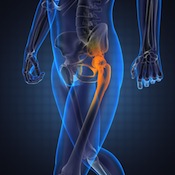What Is Hip Replacement?
 Hip replacement surgery involves removing and replacing some or all of the bones in the hip joint. In addition to the risk of dislocation, metal on metal implants rubbing together can fracture or chip, releasing metallic particles or metal ions into the body. This can lead to metallosis – metal poisoning – which can cause device failure, pain and disability severe enough to require additional hip surgery. Some patients have even developed tumors called aseptic lymphocytic vasculitis associated lesions, which destroy blood vessels and muscles. In some cases, recalls are issued when these parts show a particularly high failure rate. A Smith and Nephew hip recall was issued in such a case.
Hip replacement surgery involves removing and replacing some or all of the bones in the hip joint. In addition to the risk of dislocation, metal on metal implants rubbing together can fracture or chip, releasing metallic particles or metal ions into the body. This can lead to metallosis – metal poisoning – which can cause device failure, pain and disability severe enough to require additional hip surgery. Some patients have even developed tumors called aseptic lymphocytic vasculitis associated lesions, which destroy blood vessels and muscles. In some cases, recalls are issued when these parts show a particularly high failure rate. A Smith and Nephew hip recall was issued in such a case.
What Is Hip Resurfacing?
Hip resurfacing involves placing metal over the existing surfaces of the hip joint. Instead of replacing the worn-out thigh bone with a prosthesis, the ball is simply covered with a smooth metal cap. The benefit is that only a few centimeters of bone are removed, as opposed to entire bones, so more of the patient’s bone structure is retained. However, they still carry a risk of metal on metal wear and the same injuries that are caused by hip replacement.
Smith and Nephew Hip Recall and Lawsuits
 Smith & Nephew, Inc. is a British company manufacturing all-metal artificial hip systems, with its American headquarters in Memphis, Tennessee. On June 1, 2012, Smith & Nephew recalled the optional metal liner component of its total hip replacement system, the R3 Acetabular System, due to high failure rates. Patients have reported fracture, dislocation, and infection. It has been estimated that at least 7,700 patients have been affected by the Smith and Nephew hip recall.
Smith & Nephew, Inc. is a British company manufacturing all-metal artificial hip systems, with its American headquarters in Memphis, Tennessee. On June 1, 2012, Smith & Nephew recalled the optional metal liner component of its total hip replacement system, the R3 Acetabular System, due to high failure rates. Patients have reported fracture, dislocation, and infection. It has been estimated that at least 7,700 patients have been affected by the Smith and Nephew hip recall.
According to the Food & Drug Administration, the R3 metal liner was not cleared for use with the R3 Acetabular System. It was only approved for use with Smith & Nephew’s resurfacing product: the Birmingham Hip Resurfacing System. The Birmingham Hip Resurfacing System has been the focus of a number of lawsuits brought by patients who have experienced dislocation or metallosis.
Other Hip Replacement Recalls and Lawsuits
In August 2010, DePuy Orthopaedics, a subsidiary of Johnson & Johnson, issued a worldwide recall of its ASR hip implant devices. It has been estimated that at least 93,000 patients have been affected by that recall.
Other manufacturers of metal on metal hip replacement systems include Biomet, Zimmer Holdings, Stryker Corporation and Wright Medical Technology. Thousands of lawsuits have been filed across the country against the various manufacturers. Additional information can be found on these pages:
What If I Have Been Injured by Hip Replacement or Hip Resurfacing Surgery?
If you have undergone any hip replacement or resurfacing surgery that has led to problems such as displacement, fracturing, metallosis, or more serious injuries, contact Lopez McHugh for a free legal consultation. And remember to consult with your doctor if you have any ongoing symptoms or health concerns.
